I've spent years tracking my heart rate across countless workouts, and I can tell you firsthand that the difference between mediocre and exceptional fitness results often comes down to how well you monitor your cardiovascular response. Whether you're an elite athlete or just starting your fitness journey, understanding your heart rate patterns isn't just about watching numbers rise and fall – it's about revealing the precise data you need to optimize every training session. Let me show you how the right monitoring approach can transform your workouts and help you achieve results you never thought possible.
Key Takeaways
- ECG chest straps provide superior accuracy compared to wrist-based monitors, especially during high-intensity workouts and vigorous activities.
- Target specific heart rate zones (50-90% of maximum) to optimize workout effectiveness and prevent overtraining.
- Choose monitoring devices based on activity type: chest straps for intense training, wrist-based for running, arm-based for swimming.
- Track resting heart rate and recovery times consistently to measure fitness improvements and adjust training intensity accordingly.
- Consider factors like skin tone, proper device placement, and environmental conditions to ensure accurate heart rate measurements.
Understanding Heart Rate Monitor Technologies
Anyone interested in fitness tracking has likely encountered the two main types of heart rate monitoring technologies: ECG chest straps and PPG optical sensors.
Let me explain how each works and their key differences.
ECG chest straps use electrodes to detect electrical signals from your heart, providing highly accurate readings even during intense exercise. I recommend these if you're serious about athletic training or need precise data for performance optimization. Regular cleaning with soap will help maintain optimal performance and extend the life of your chest strap.
They'll also give you additional metrics like running cadence and ground contact time. For serious athletes, the Garmin HRM-Pro is particularly effective at tracking these advanced metrics.
PPG sensors, commonly found in smartwatches and fitness bands, work differently. They use LED lights and photodetectors to measure blood volume changes in your tissues. While they're more convenient than chest straps, I need to point out that they're generally less accurate, especially during high-intensity activities.
Motion artifacts and ambient light can affect their readings.
When choosing between the two, consider your needs. If you're a competitive athlete or require detailed heart rate data, go with an ECG chest strap.
If you're tracking general fitness and don't mind occasional accuracy variations, a PPG-based device will serve you well.
Choosing The Right Monitoring Device
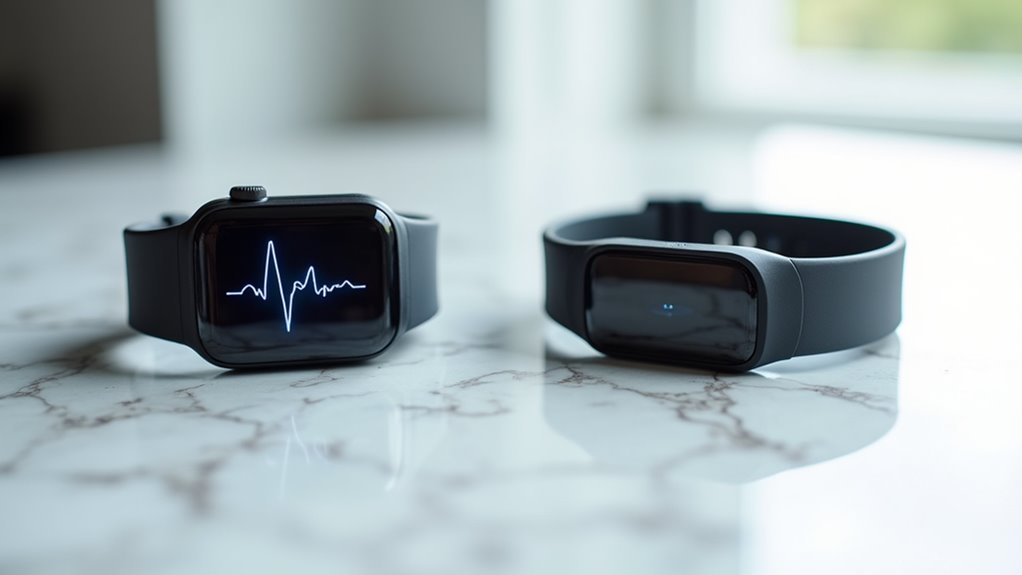
In today's market, selecting the right heart rate monitoring device can feel overwhelming due to the variety of options available. I'll help you narrow down your choices based on your specific needs and activities.
For overall fitness tracking, I recommend the Fitbit Versa 4, which offers extensive monitoring of heart rate, sleep, and daily activities with up to 6 days of battery life. If you're focused on specific sports, consider the Garmin HRM-Pro for running or the Polar Verity Sense for swimming. Athletes seeking advanced insights might prefer the WHOOP 4.0 Band with its 5-day battery life and comprehensive health metrics tracking. Recent studies have shown that optical heart rate monitors perform better with younger populations during various exercises.
| Activity Type | Best Device | Key Features |
|---|---|---|
| Running | Garmin HRM-Pro | Cadence, vertical oscillation metrics |
| Swimming | Polar Verity Sense | Water resistance, high accuracy |
| Daily Fitness | Fitbit Versa 4 | Sleep tracking, GPS, phone notifications |
For the most accurate readings, the Polar H10 Heart Rate Sensor stands as the gold standard in wireless monitoring. If you're budget-conscious, the Coospo H6 offers excellent value while maintaining reliable functionality. Those prioritizing comfort should look at the Wahoo TICKR X, which provides a comfortable fit during intense workouts while delivering accurate data across multiple sports.
Accuracy Factors and Device Reliability
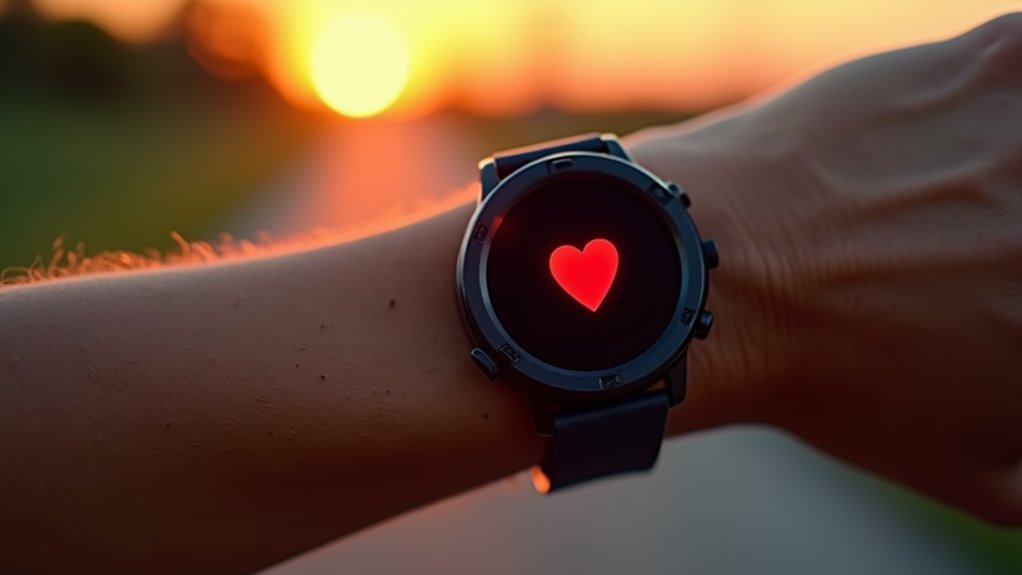
Now that you've selected your heart rate monitor, understanding what affects its accuracy will help you get the most reliable readings. Several key factors influence how accurately your device measures heart rate, including exercise intensity, skin tone, and environmental conditions. Chest strap monitors offer superior accuracy compared to wrist-based devices.
I've found that proper device placement and fit are essential for getting consistent measurements. Athletes see best results when using heart rate data to optimize their training regimes.
While wrist-worn devices use PPG technology to measure heart rate through light absorption, they're generally less accurate than chest straps, especially during intense exercise. If you're seeing unusual readings, check that your device is snug but not too tight, and positioned correctly according to the manufacturer's guidelines.
For the most reliable data, I recommend being aware of potential interference factors. Motion artifacts, temperature changes, and even compression can affect your readings.
If you have darker skin, you might notice slightly less accurate measurements due to how PPG technology interacts with different skin tones.
While these devices provide valuable fitness insights, remember they're not medical devices – if you notice persistent irregularities in your heart rate, I always suggest consulting a healthcare professional.
Maximizing Your Workout Performance
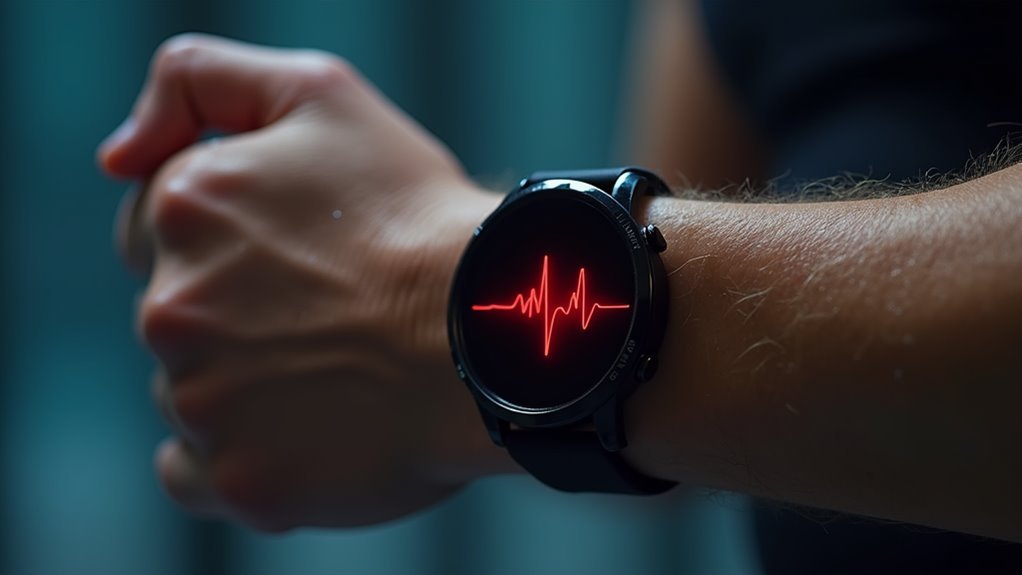
Making the most of your heart rate monitor can revolutionize your workout performance.
I'll show you how to use your heart rate data to achieve ideal results in every training session. By targeting specific heart rate zones, you'll eliminate inefficient "junk miles" and guarantee each workout serves its intended purpose, whether that's building endurance, increasing speed, or promoting recovery.
To maximize your workouts, I recommend starting with your target heart rate range, typically 50-90% of your maximum heart rate. For moderate-intensity training, aim for 50-60% of your MHR, while vigorous workouts should fall between 65-90%. Chest strap monitors provide the most accurate heart rate readings by directly measuring electrical signals from your heart. The perceived exertion method can help validate your heart rate readings during exercise.
I find combining heart rate data with the talk test and RPE provides the most thorough view of your exercise intensity.
What's particularly valuable about heart rate monitoring is how it helps you pace yourself effectively and track improvements over time. You'll notice positive changes through a lower resting heart rate and faster recovery times.
I suggest using this data to enhance your training schedule, guaranteeing proper rest periods and preventing overexertion. This systematic approach to monitoring will help you achieve your fitness goals more efficiently and effectively.
Data Integration Across Fitness Apps
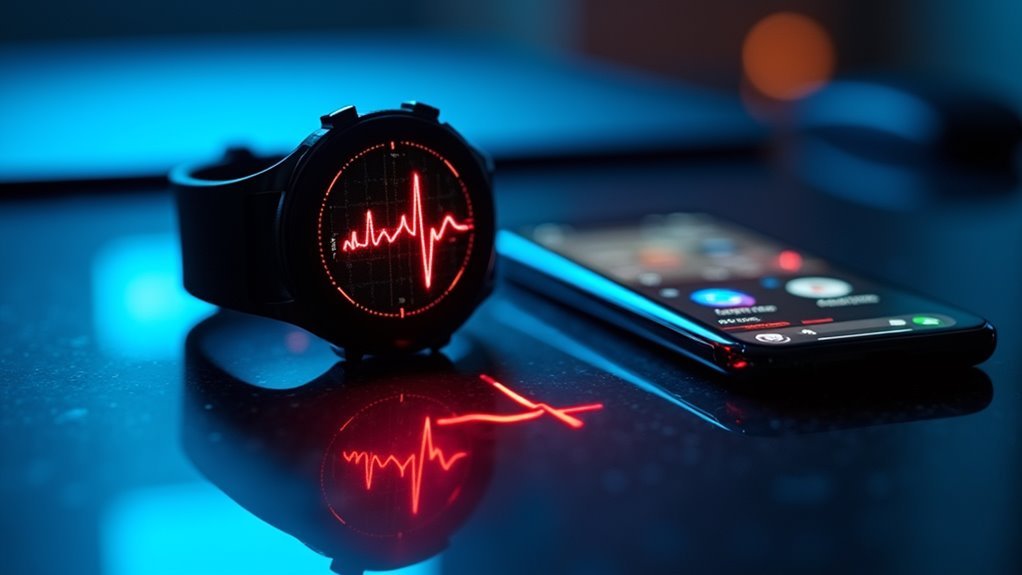
Data integration revolutionizes how we track and analyze fitness progress across multiple platforms. I've found that connecting apps like Strava, Garmin, and Fitbit through their APIs creates a thorough view of your fitness journey, though it's not without its challenges.
When you're syncing data across multiple platforms, you'll want to watch for potential inconsistencies. I recommend using apps that offer both manual and automated data input options, like those compatible with Apple HealthKit, to guarantee you're capturing all your metrics accurately. This flexibility becomes essential when tracking heart rate, steps, and other critical statistics across different devices. Modern fitness platforms support geofencing alerts to help you stay on track during outdoor workouts. Many health insurers now offer bonus rewards for sharing fitness tracking data.
To protect your privacy, I suggest enabling encrypted communications and keeping your location data private by default. Don't forget to check your sharing settings regularly, as public fitness data can expose more information than you might realize.
For the best experience, look for apps that offer real-time synchronization with your wearables. The most effective platforms combine this technical reliability with engaging features like personalized insights and social connectivity, helping you stay motivated while maintaining accurate tracking of your fitness metrics.
Monitoring Methods for Different Sports
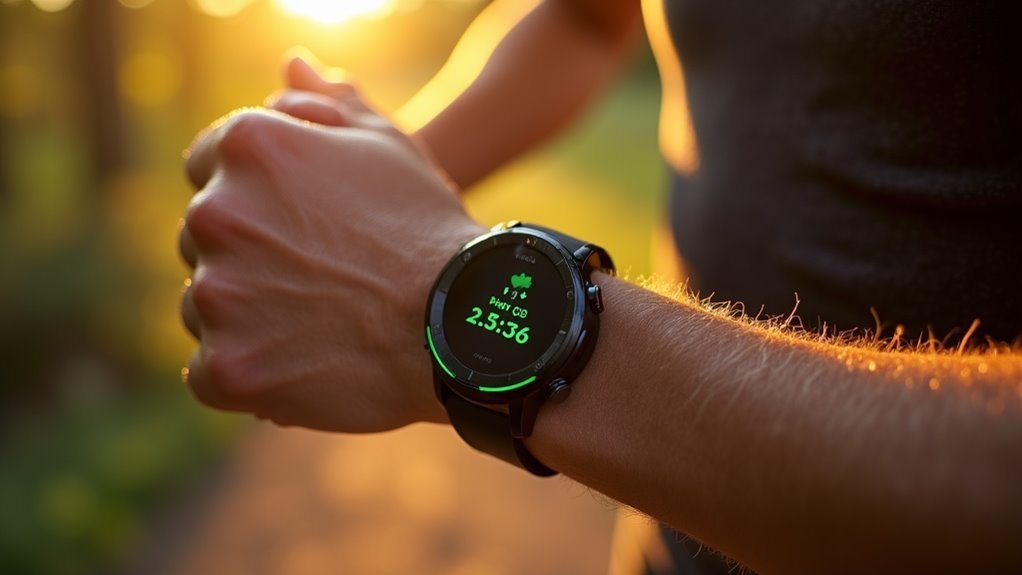
When choosing a heart rate monitor for your sport, understanding the strengths and limitations of different monitoring methods is essential. I'll help you select the most effective option based on your specific activity.
For swimming, I recommend an arm-based optical monitor with a goggle strap clip. It's designed to stay in place and maintain accuracy in the water.
If you're into high-intensity training or sports with vigorous movements, I strongly suggest using a chest strap monitor. While it requires some extra maintenance and needs to be wet for peak performance, it's the most reliable option for accurate readings during intense activities.
For activities like running or cycling, where you're not making excessive hand movements, a wrist-based optical monitor can work well.
However, if you're serious about training or participating in longer duration activities, I'd still recommend a chest strap. It provides consistent readings regardless of movement and won't be affected by factors like skin tone or tattoos.
Frequently Asked Questions
Can Heart Rate Monitors Detect Irregular Heartbeats or Potential Cardiac Issues?
I've found that modern heart rate monitors detect irregular heartbeats with up to 93% sensitivity. They'll catch atrial fibrillation and other arrhythmias through PPG technology and ECG measurements.
How Often Should I Replace or Recharge My Heart Rate Monitor Battery?
I recommend replacing CR2025 batteries when readings become irregular, typically every few months. For rechargeable monitors, charge them when battery drops below 20%, usually every 4-5 days.
Is It Safe to Wear a Heart Rate Monitor During Pregnancy?
As your heart rate increases 15-20% in the third trimester, wearing a heart rate monitor during pregnancy is safe. There's no evidence of harmful effects, but I recommend consulting your healthcare provider first.
Can I Swim While Wearing My Heart Rate Monitoring Device?
Yes, you can swim with specific waterproof heart rate monitors like the Garmin HRM-Swim, Polar H10, or FORM Swim Goggles. I recommend choosing one that's designed for swimming to guarantee accurate tracking.
Do Tattoos or Dark Skin Affect Optical Heart Rate Monitor Accuracy?
I'll tell you the truth: both dark tattoos and darker skin can affect heart rate monitoring accuracy. Your device may need more power and could struggle to get consistent readings.